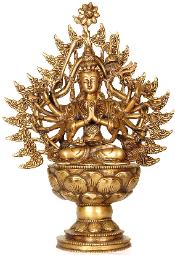The paragraphs below are extracted from
http://www.mykwanyin.com/kwgoddess.html
Entwined in the faith of Buddhism, her first real appearance in literature seems to be around 400 AD. By that time, Buddhism had been around for nearly 1000 years, spreading from its birthplace in India to China, and subsequently to Korea, Japan and Tibet.
Devotees of Avalokitesvara, or Avalokita, Bodhisattva of Compassion of Indian Buddhism, brought the concept of Avalokita to China. There, Avalokita, or Kwan Yin, was adopted as a god in the male form and later was gradually changed by some to resemble a female, lending a rather androgynous element to her.
By 1200 AD she was definitely a female portrayed in flowing robes.
Avalokita is depicted with many arms, hands and heads, sometimes with an eye in each palm representing the ever watchful omnipresent mother, ready to immediately reach out in any direction to alleviate suffering.
In Buddhist mythology, it states that Avalokita was born from Amitabha Buddha's right eye, after which he proclaimed, "Om Mani Padme Hum" -- Hail to the jewel in the lotus -- a sentiment of her preciousness to him. Some believe she is actually an incarnation of Amitabha Buddha.
The Chinese translation of the Sanskrit Avalokita is Kuan shih Yin, the full form of the shortened Kuan Yin, or Kwan Yin.
Entwined in the faith of Buddhism, her first real appearance in literature seems to be around 400 AD. By that time, Buddhism had been around for nearly 1000 years, spreading from its birthplace in India to China, and subsequently to Korea, Japan and Tibet.
Devotees of Avalokitesvara, or Avalokita, Bodhisattva of Compassion of Indian Buddhism, brought the concept of Avalokita to China. There, Avalokita, or Kwan Yin, was adopted as a god in the male form and later was gradually changed by some to resemble a female, lending a rather androgynous element to her.
By 1200 AD she was definitely a female portrayed in flowing robes.
Avalokita is depicted with many arms, hands and heads, sometimes with an eye in each palm representing the ever watchful omnipresent mother, ready to immediately reach out in any direction to alleviate suffering.
In Buddhist mythology, it states that Avalokita was born from Amitabha Buddha's right eye, after which he proclaimed, "Om Mani Padme Hum" -- Hail to the jewel in the lotus -- a sentiment of her preciousness to him. Some believe she is actually an incarnation of Amitabha Buddha.
The Chinese translation of the Sanskrit Avalokita is Kuan shih Yin, the full form of the shortened Kuan Yin, or Kwan Yin.


No comments:
Post a Comment